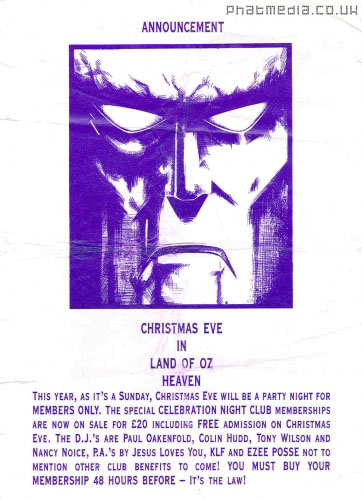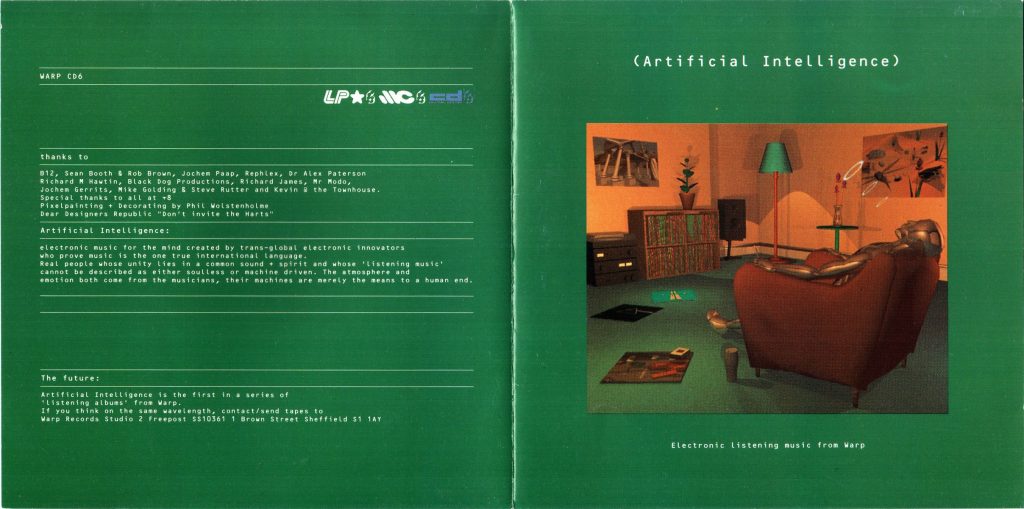Immediately after the Second Summer of Love, Ambient House/Techno grew as an offshoot of Acid House and was usually played in the chill out rooms of all night dance clubs, or at home with headphones. It developed during the 90s in the UK, alongside rave and jungle, among others, but incorporated influences from progressive rock and ambient music. Mostly listened to off the dance floor, Ambient House/Techno grew out of London clubs and into a leisure activity with a reduced focus on the groove and an increased focus on ambient music that could not be danced to.
Ambient House
One of the first subgenres to emerge from the UK during the emergence of Acid House, Ambient House took inspiration from artists like Brian Eno, Pink Floyd and the dub music of Lee “Scratch” Perry. The beginnings of the music can be traced to the late 80s in the London nightclub Heaven, with Paul Oakenfold’s “Land of Oz” events. But it was the club’s “White Room” where Alex Paterson and Jimmy Cauty played ambient music to punters looking to relax and come down from the frenzied pace of more beat-driven music. The duo DJed and produced under the name The Orb, and would often spin Acid House tracks without percussion and layered with BBC samples and other material to produce an audio/visual experience heavy with effects.

The performances eventually produced The Orb’s 1989 A Huge Ever Growing Pulsating Brain That Rules from the Centre of the Ultraworld, a 19-minute live mix recorded for John Peel’s BBC Radio 1 program and originally titled “Loving You” from the Minnie Riperton sample used. Jimmy Cauty also produced Chill Out, taking some material from the same production sessions with Paterson at Cauty’s Trancentral studio and releasing it with KLF partner Bill Drummond under their KLF Communcations label in 1990. With their DJ sets and studio work, Alex Paterson and Jimmy Cauty created the template for Ambient House.
However, a falling out between Cauty and Paterson over whether to release more of their work under the KLF label ended their collaborations. Alex Paterson to continue working under The Orb name with Martin “Youth” Glover, bassist of Killing Joke, childhood friend of Paterson and one of the original DJs of “The White Room” sets. The Orb would go to continue making music for decades with a rotating cast of musicians, but with Paterson mostly at the center. Cauty would continue a little longer with The KLF before selling the most singles of any British group in 1991 and then burning a million quid while exiting the music industry.
Ambient House was not a genre that produced a lot of singles, because most of the first musicians releasing music in this genre were DJs that refined their sets down to EP length songs. One example, The Orb’s Blue Room, peaked at #8 in the UK in 1992 and at 39 minutes is still the longest single ever to chart. The KLF’s Chill Out is also meant to be listened to straight through, attempting to provide a musical journey through the American Southeast in 45 minutes. The classic album features samples of Elvis, steel guitar and a traveling salesman’s pitch and is highly recommended.
Considering how small this key group of artists was and its genesis in a single club, its influence on the music scene in the UK is very impressive. And an inspiration for anyone who wants to stay afloat in the music industry for over a decade before becoming hugely successful and flaming out in spectacular fashion, as The KLF did.
The Orb – Little Fluffy Clouds (1990)
The first track on The Orb’s Adventures Beyond the Ultraworld LP, Alex Paterson worked with Martin “Youth” Glover to create this track blending a Steve Reich/Pat Metheny guitar piece with a Rickie Lee Jones interview and the drums from Harry Nilsson’s Jump into the Fire. One of The Orb’s best known songs, Little Fluffy Clouds proved so popular Rickie Lee Jones sued the group and Steve Reich negotiated a settlement for the use of his music. What were the skies like when you were young?
The Irresistible Force – Flying High (1992)
Mixmaster Morris released three albums as The Irresistible Force in the 90s but is mostly known as an eclectic DJ who continues to perform chill out sets, carrying the ambient dance music torch for about 30 years. He is often saddled with the unfortunate quote “I think therefore I ambient”, which expressed more of an optimism for the music and a reaction to the debilitating drug intake of The Shamen, for whom he performed as a tour DJ before achieving his own success. Flying High is a classic album of the genre, and the title track is a great example of synths, effects and light percussion.
Amorphous Androgynous – Mountain Goat (1993)
The Future Sound of London were one of the major acts of 90s British electronic music, and the Amorphous Androgynous name features more psychedelic influences and ambient sounds than much of their other music. Their 1993 LP Tales of Ephedrina displays a shift from Acid House/Rave to a more ambient sound, one that would reach its best expression in the FSOL double album Lifeforms. Mountain Goat is still one of their most popular songs and shows the duo’s proficiency and attention to detail in the studio.
The KLF – Madrugada Eterna (1990)
Chill Out is an album that must be listened to in its entirety to be appreciated, but there are some definite highlights like Madrugada Eterna. See also the club mix featuring excerpts from the unfinished film The White Room that they produced during this time. A classic album from an inimitable group, Chill Out remains one of the best albums of the 90s. While much of the music came from the sessions between Jimmy Cauty and Alex Paterson, Paterson is not credited as a songwriter.
The KLF – Neptune (1990)
Released on The KLF’s Space LP, Neptune is another example of Ambient House in the early 90s. Space was released by KLF Communications after Alex Paterson left The Orb, and was originally to be the duo’s debut. A disagreement over who would release the album, and whether it would be another of The KLF’s projects rather than an independent entity led to the professional split of Cauty and Paterson. As a result, Cauty took all of Paterson’s parts out and replaced them and released this as a KLF album.
Ambient Techno
In the early 90s, the growth of Acid House and dance music in the UK produced a very fertile scene for all kinds of electronic music that nurtured greater numbers of listeners. Ambient House music catered to an audience who wanted to chill out, and the influence of House, Techno and Dub music continued to grow on the artists and DJs in the UK. In the northern city of Sheffield, Warp Records became known for the “bleep” Techno of LFO and Sweet Exorcist in the early 90s but would be more successful promoting what it termed “Intelligent Dance Music” in the middle years of the decade. This post will focus specifically on the Ambient Techno/IDM being produced and released on Warp Records.
Seeing an opportunity created by Ambient House, Warp released electronic music for audience listening to the music at home and its Artificial Intelligence record series showcased up and coming artists making “post-Rave” music for more “cerebral” listeners. The album cover of the first compilation, released in 1992, shows a robot reclining in a chair with a brew, a smoke and copies of Dark Side of the Moon and Kraftwerk’s Autobahn. The insultingly named IDM caught on and the artists on this compilation all became very successful, despite or because of that label.

The contributing artists on this compilation make up the primary artists of IDM, including Aphex Twin, Autechre, Black Dog, B12, Speedy J and Alex Paterson again, with a live version of Loving You to close the album. What distinguishes this music from the work of The Orb and Ambient House is the prevalence of rhythms, crisp percussion and bleep-y synths in place of the loops and vocal samples. The presence of Richie Hawtin, who would inspire and release albums by these artists, also cements the imprint of Detroit.
Warp released some of the best albums in electronic music in the 90s as the original artists of the Artificial Intelligence began to produce drastically different music on the label. Albums like Aphex Twin’s Selected Ambient Works Volume 2, Autechre’s Tri Repetae, The Black Dog’s Spanners and B12’s Electro-Soma all very different. The label also released Squarepusher’s jazz/breakbeat fusion in the 90s after Richard D. James vouched for Warp, and would eventually land one of the biggest acts in Ambient Techno when they signed Scottish brothers Marcos Eoin and Michael Sandison, or Boards of Canada. They are one of the most successful acts in all of electronic music, and their work is probably the most realized example of the electronic listening music that Warp began to promote in the 90s.
Most of the artists and Warp moved beyond the Bleep and Ambient Techno released in the early 90s, and amazingly became very successful blazing their own trail after the explosion of Raves and electronic music. Warp went on release all of Boards of Canada’s albums, and now releases music from a diverse set of artists like Flying Lotus and Oneohtrix Point Never. The other artists on the Artificial Intelligence compilation would continue to expand “IDM” music, influenced by Jungle and enabled by samplers and music production/sequencing software to produce glitch, drill’n’bass and other music that would be unbearingly tedious to produce any other way.
B12 – Hall of Mirrors (1993)
Taking influence from the Windsor-based Plus8 label, Steven Rutter and Mike Golding released many songs in the 90s under a variety of aliases, on their own label and on Warp. Of all of the music in this post, B12 most closely resembles the music coming from Detroit and its production by Roland drum machines and synthesizers. The duo is again recording music together today after a long period of inactivity and personal turmoil. While they never achieved the fame that some of the other artists here did, B12 was very influential in the early to mid 90s and a major name on the Warp roster.
Squarepusher – Beep Street (1997)
Tom Jenkinson displays his love of jazz most prominently in the electric bass that appears throughout his music, but the musical and digital sample chops place his music often alongside Aphex Twin in the IDM category. Not an early artist on the Warp label, Squarepusher fits in with the mid to late 90s breakbeat scene that took the influence of Jungle and computer sequencing to produce very dense and undanceable music.
The Dice Man – Polygon Window (1992)
Richard D. James is probably the face of Ambient Techno under the Aphex Twin name. After releasing Selected Ambient Works 85-92, Aphex Twin immediately became very popular and remained very prolific. James released the Surfing on Sine Waves LP under the Polygon Window name in 1993, SelectedAmbient Works II in 1994, and a ton more material for the next decade and a half. Aphex Twin achieved a great deal of crossover success in the late 90s, with some of his videos made with Chris Cunningham getting airplay on MTV. Aphex Twin’s music veers from frantic, drill’n’bass rhythms to very sunny melodies and has been at the forefront of many musical innovations. He’s still making great music and believing his Truther beliefs today.
Autechre – Eutow (1995)
Adopting more of a noise/glitch sound, Autechre produced a lot of very unique and challenging music throughout the decade. Eutow is an example of one of their accessible songs, while songs like jatavee c are unlike any of the early music they produced for Warp, but still have some of the same sounds heard on Artificial Intelligence.
I.A.O. – The Clan (1992)
I.A.O. is The Black Dog, and this song was also released on their debut album Bytes in 1993. The group would develop the sound over many aliases, but the thin percussion and repetitive melodies usually characterize their music. Even their alias Plaid’s Scoobs in Columbia follows the same formula with completely different sounds to great effect, demonstrating the group’s talent and range.
Boards of Canada – Telephasic Workshop (1998)
Music Has the Right to Children is the album that broke Boards of Canada into the mainstream, and it remains a fascinating listen. The Sandison brothers are arguably the most famous group in electronic music in the 21st Century, and the universality of their music makes it pretty easy to understand why. Clearly electronic, their early music was produced with only a couple samplers, Yamaha synthesizer, reel-to-reel tape machine and a Roland SH-101, but the achievement is so great that its hard to believe the music came from such a small amount of gear. Boards of Canada managed to genuinely evoke a sense of nostalgia and childhood that perhaps no other artist has done so well, and long before nostalgia came to be a selling point itself for a lot of electronic music, or kitsch in this case.
Bandulu – Revelation (1993)
While Warp released a lot of very influential albums, their artists weren’t the only ones releasing this type of music, and Bandulu could sound very similar to contemporary acts like B12 and The Black Dog. While Revelation is an example of the straightforward Ambient Techno also promoted by Warp in the early 90’s, along with the dub and jazz influences becoming popular in techno from the time.
Speedy J – De-Orbit (1991)
Jochem George Paap is a Rotterdam-based DJ and producer whose early releases were on Richie Hawtin’s Plus8 label in Canada and on Warp in the UK. While De-Orbit is a pretty standard Ambient Techno track with a bleepy synth and a breakbeat, Speedy J’s other work sometimes sounds like a brutal Belgian version of the other music on the Warp catalogue. Along with Autechre and Aphex Twin, Speedy J pushed the boundaries of Techno music in the mid to late 90s and helped to define how the music would sound into the 2000s.
Additional Material
San Francisco-based Rave culture website hypperreal.org that once hosted the IDM mailing list and Brian Eno’s official website. Such an artifact, Wow!
Red Bull Music Academy interview with Warp co-founder Steve Beckett
Dutch TV interview with Tom Jenkinson (Squarepusher)
John Peel interviews Richard D. James and Luke Vibert
